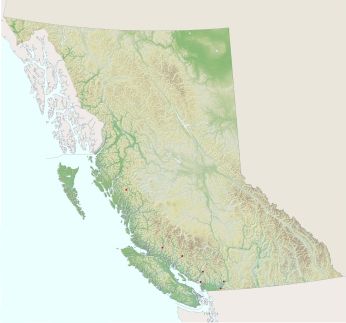Abundant fossils show that the petaltails flourished in the Jurassic Period, at least 150 million years ago, well before the landmass that is now B.C. and the Yukon existed. Today, 11 species persist in widely scattered regions — New Zealand, Australia, Chile, Japan, the Appalachian Mountains and western North America. The eyes of petaltails are separated and the pterostigma is long and narrow; females have an ovipositor. Larvae live where water seeps and trickles over the ground, and many species make burrows; they are amphibious, spending much time out of water.
|
Lives at mid to high elevations in the Cascade and southern Coast mountains, and at sea level on the central coast to about 53°N. Larvae burrow in mud and moss saturated by trickling water seeping from hillsides; many burrows can be concentrated in a small area. Adults perch on tree trunks, logs, rocks and the ground. They can be tame and frequently land on people.
|
|
